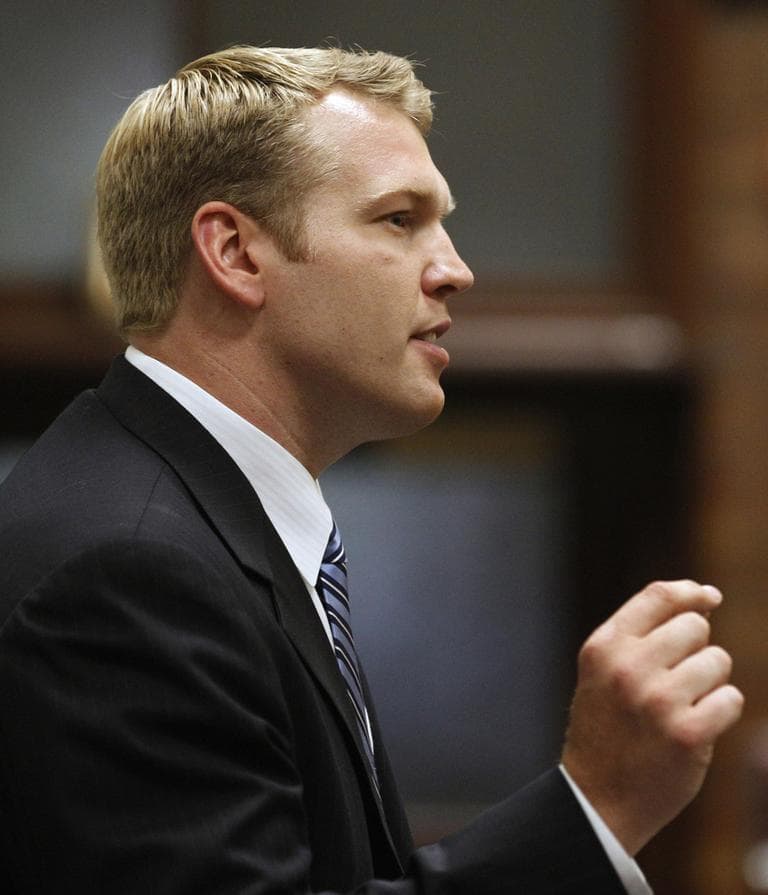Advertisement
Advocate: Youth Sports Not Doing Enough To Protect Players From Head Injuries
Resume
Chris Nowinski once made a living getting hit in the head. He was a Harvard University football player and later a professional wrestler for World Wrestling Entertainment. But he quit after a series of concussions left him with headaches and short-term memory loss.
Nowinski’s passion is now preventing concussions in sports. He’s co-director of Boston University’s Center for the Study of Traumatic Encephalopathy, a book he wrote called “Head Games” has just become a movie by the same name (it opens in Boston Oct. 5), and on Thursday he’ll be talking about sports-related brain injuries at a Ford Hall Forum at Suffolk University.
When WBUR’s All Things Considered host Sacha Pfeiffer recently spoke with Nowinski, he said professional leagues like the NFL do much better now at safeguarding athletes, but youth sports still have a way to go.
Chris Nowinski: Our professionals are actually very well-protected now, with all the rule changes and the medical infrastructure. But the sad thing is we offer none of those things for children. We don’t give them athletic trainers and doctors on the sideline. We don’t give them education. And so one of my goals with this is people start to rethink: when do you start exposing a child to repeated brain trauma? Because they’re too young to even understand what’s happening.

Sacha Pfeiffer: I want to play a clip from the movie where Dr. Robert Cantu of Boston University is talking about kids playing contact sports:
I think it’s absolutely insane that little kids are bashing heads with football helmets on. Their brains are not myelinated, their heads are disproportionately big, their necks are overwhelmingly weaker than they will be later, and trauma that they sustain often seems to last longer before it clears.
The point Dr. Cantu seems to be making here, of course, is that protecting kids isn’t just as important as protecting pro athletes – it’s more important.
Right. When an adult gets a concussion, you see a drop-off in their production and their feelings. But with a child it’s really hard to see, because children are picking up new cognitive skills so quickly that if they start slowing down or if they start dropping behind their classmates, it’s harder to see.
I mean, you wonder about all these children who are diagnosed with ADHD or attention problems or behavior difficulties, just randomly at 10 or 12 years old, and knowing they’ve been hit in the head regularly for the last five years — you wonder if that’s an organic problem or did we create that? Some people have thrown out the idea of: Where did the dumb jock stereotype come from? Is it a chicken or the egg? Were they a dumb jock when they went in? Or was it starting to hit them in the head at 6 years old that made them a little dumber, that made them have behavioral problems?
I want to play another clip from the movie of some young athletes — they may not even be in high school yet — being asked about how concerned they are about possibly getting concussions:
Adult male voice: “Do you think it’s good to know more about concussions, or would you just rather not know?”
Young player: “Not know too much about them. Because if I get one, it kind of scares me. Like, what happens if I have this? But since I don’t know, I just — I like it better that way.”
Adult male voice: “So when your dad talks to you about concussions, you’d prefer he doesn’t really tell you too much?”
Young player: “Yeah.”
Adult male voice: “Does he know that?”
Young player: “No.”
Given that attitude, how much of a challenge do you think it’s going to be to get young athletes to take this seriously?
It’s going to be an enormous challenge. I think we all appreciate that teenagers and children don’t do a good job thinking long-term. And so you look at other public health problems like this — I think smoking’s the best example. Something you do as a young person is going to cause lung cancer 30 years later. We understood that children did not get it, that they couldn’t understand that that little cigarette could do that. And so we banned it. We banned children smoking, you can’t sell to them, can’t even advertise to them. But yet you’re allowed to start hitting children in the head, that could give them a disease that will hurt them 30 years later that they can’t possibly appreciate. From a public health perspective, that’s very out of whack.
What do you think should change in youth sports to try to protect kids’ heads?
The biggest thing is getting rid of the idea of collision sports for kids. Contact to the head should be rare and should be accidental. And so one of the things is something called a hit count, actually setting a limit to how often you can hit a child in the head for sports. There’s a pitch count in baseball that everyone’s bought into: that if you throw too many times, you’re going to wear out your elbow. And so kids actually have to stop at 75 if they’re 11 years old. Well, we know if you get hit in the head too much you’re going to wear out your brain. Some kids are taking thousands of blows to the head, whether it’s football or soccer or ice hockey or any of these sports. So we want to start measuring this to show parents, like, do you think it’s a good idea to be hitting any child in the head a thousand times a year?
I think most parents would say, “Of course I don’t want my kid hit in the head.” But they may want their kid to play sports. So what about those accidental occasions? How do we reduce those?
A lot of it is actually analyzing the sports — how do these happen, what are the drills — and changing them and setting guidelines. There’s hundreds of drills that are used in football — to actually put a number to them of how dangerous they are and actually try to get underneath a number for all the drills that you teach. To just try to say, “How can we teach this sport by minimizing risk of brain trauma?”
For soccer it’s pretty easy; a lot of the head trauma comes from trying to do headers. It’s those collisions of people jumping in the air and bumping heads or elbows to heads, and also the repetitive trauma that comes with headers, and taking some rationale to that. That there’s actually an age where you should start throwing a soccer ball at a child’s head and it’s not in single digits. But so many people are doing it.
This program aired on September 25, 2012.
